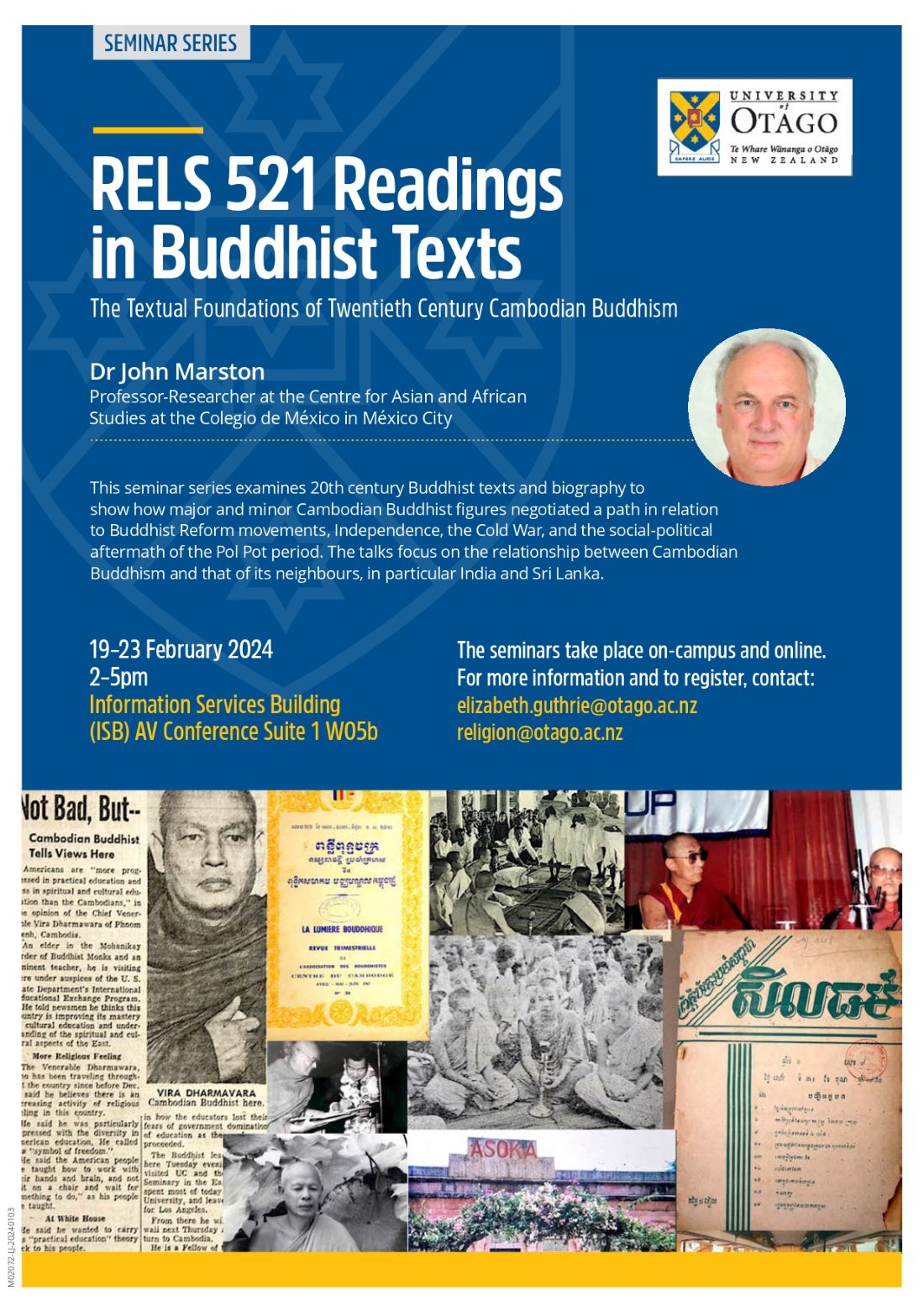Under the MoU between the Dhammachai International Research Institute (DIRI) and the Religion Programme, the University of Otago, we are pleased to invite everyone to join the Buddhist Texts seminar series between 19-23 February 2024, 2-5 pm (NZ time).
This seminar series examines 20th century Buddhist texts and biography to show how major and minor Cambodian Buddhist figures negotiated a path in relation to Buddhist Reform movements, Independence, the Cold War, and the social-political aftermath of the Pol Pot period. The talks focus on the relationship between Cambodian Buddhism and that of its neighbours, in particular India and Sri Lanka.
Those interested can attend in person or virtually (via zoom) through this link :
https://otago.zoom.us/j/99433897849?pwd=c3JJbFlHNUxsWWtGQTh4eEJiRGhBUT09
Meeting ID: 994 3389 7849
Password: 027840
Syllabus of this seminar as shown below:
Monday, February 19
Class 1: Dharmawara Mahathera and Buddha Jayanti Period Transitions
Required:
R1 Marston, John. 2022. “Dharmawara Mahathera, Sihanouk, and the Cultural Interface of Cambodia’s Cold War Relations with India.” Southeast Asian Studies, Vol 11 (2): 219-47. [doi:10.20495/seas.11.2_219]
R2 Norodom Sihanouk.1963. “Our Buddhist Socialism.” Kambuja: Monthly Illustrated Review, Nov. 15, 1963, Pp. 11-8
R3 Dharmawara Mahathera, Ven. Bhikkhu Vira.1956. Through Light to Peace. Bangkok: Organization for the Promotion of Arya Dhamma in India
Tuesday February 20
Class 2: Sīmās and the Ambiguities of Reformed Buddhism in Cambodia
Required:
R4 Marston, John A., Chhuon Hoeur, y Elizabeth Guthrie. 2022. “Analysis of Simas (Boundaries).” In Simas: Foundations of Buddhist Religion, Jason A. Carbine y Erik Davis, eds. Honolulu: Univerity of Hawaii Press, pp. 265-296.
Recommended: Other chapters in Carbine and Davis book
Wednesday February 21
Class 3: The Asia Foundation and Cambodian Monks in India
Required:
R5 Marston, John A. “The Asia Foundation and Cambodian Monks Studying in India.” (English version of article published in Spanish as: Marston, John. 2020. “La Fundación Asia y los monjes Camboyanos que estudiaron en India” In Budismo y sociedad en el Sureste de Asia. México, CDMX: El Colegio de México, pp. 107-55.)
R6 Marston, John and David Geary. 2023. “Nalanda Rising: Buddhism, Heritage Diplomacy, and the Politics of Revival.” Comparative Studies of South Asia, Africa and the Middle East Vol. 43, No. 1, 2023 [doi 10.1215/1089201X-10375331]
2
Recommended:
R7 Kashyap, Jagdish. 1968. “The Buddhist Outlook.” The Maha Bodhi Vol. 76 (1-2): 2-6, and Vol. 76 (3): 44-48.
R8 Ford, Eugene. 2017. Cold War Monks: Buddhism and America’s Secret Strategy in Southeast Asia. New Haven: Yale University Press.
Thursday February 22
Class 4. Re-establishing Monastic Lineage in Cambodia in 1979
Required:
R9 Marston, John A. 2014. “Reestablishing the Cambodian Monkhood.” In Ethnicity, Borders, and the Grassroots Interface with the State: Studies on Southeast Asia in Honor of Charles F. Keyes, John Marston, ed. Chiang Mai: Silkworm Books, pp. 65-99.
Friday February 23
Class 5. Cambodian Buddhism in India and Sri Lanka at the Present Time.
Required:
R10 John Marston. 2014. “The Transnationalism of Merit: Diaspora Commuities and Cambodian Student Monks, Pilgrims, and Building Projects in South Asia” (17th Congress of the International Association of Buddhist Studies, Vienna, Austria, Aug. 23, 2014); published in Spanish as: Marston, John A. 2020. “La Transnacionalizaciòn de mérito: Comunidades diaspora, monjes estudiantes, pergrinos y proyectors de construcción en el sureste de Asia.” In Budismo y sociedad en el Sureste de Asia. México, CDMX: El Colegio de México, pp. 197-231.
Recommended:
R11 Marston, John. 2020. “Cambodian Pilgrimage Groups in India and Sri Lanka.” In Buddhist Tourism in Asia, Courtney Bruntz y Brooke Schedneck, eds. Honolulu: University of Hawaii Press.
AV Material
Students are asked to spend some time looking at these You Tube videos which serve as texts for analysis in the above article. The article references a series of You Tube videos which can be found by Google searches on Dhamma Yeatra 2008. Here are some of the links:
d40WScIsUeNHqJlQP8&index=4
WScIsUeNHqJlQP8&index=5
0WScIsUeNHqJlQP8&index=1

